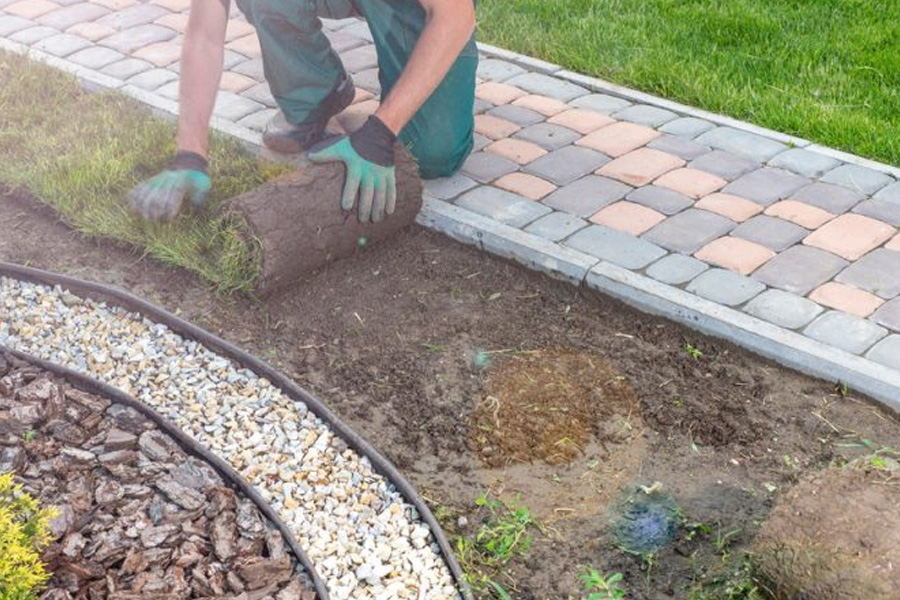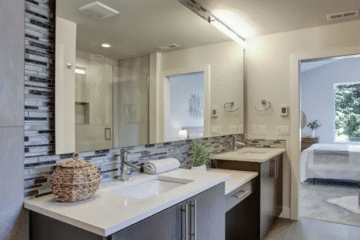How to Design a Pond for Your Garden

Image Source: modernhb.com
There’s something undeniably charming about a pond—part mirror, part magnet for wildlife. It draws in frogs, dragonflies, and curious glances from every angle.
Design it with care, and it turns your garden into a little world of its own.
Choosing the Perfect Spot for Your Pond
It all starts with where you place it. A pond needs light, but not too much, and shelter without being completely hidden away.
Aim for an area that enjoys morning or early afternoon sun, while avoiding full exposure that could invite unwanted algae. Shade from trees also seems picturesque, but fallen leaves can quickly turn water murky.
Consider how the pond fits into the wider garden. Does it sit naturally within the space? Is it visible from your favourite seating spot? Use a hose or pegs and string to map out your ideas before digging begins.
Furthermore, checking the ground is level will save headaches later while also reducing the risk of run-off from rainwater.
If your area welcomes birds, frogs, or pollinators, choose a location that encourages visits. Wildlife gives a pond its charm and turns it into a miniature ecosystem.
And of course, double-check whether there are local rules about ponds or excavation; it’s far better to be certain than to be caught off guard.
Selecting a Style That Suits Your Space
With your location sorted, your next decision is about style. What sort of pond matches your garden and your vision?
Natural ponds feel relaxed and timeless, their irregular curves melting into surrounding planting. They’re brilliant for wildlife and work beautifully in more informal gardens.
Formal ponds, by contrast, offer clean shapes and crisp edges that mirror architectural lines and lend a more structured feel.
If ease is a priority, consider preformed pond shells. These are quick to install and reliable for beginners. For greater freedom in shape and depth, flexible liners give you creative control, though they do require a bit more work during installation.
It’s also worth thinking ahead.
If you plan to introduce fish, you’ll need to ensure enough depth for them to thrive throughout the seasons. Shallow ponds can freeze in winter or overheat in summer, whereas deeper ponds keep the water temperature stable.
A quick word with professional landscapers can offer just the right guidance for your soil and climate, and might be exactly what saves the whole project from going sideways.
Shaping the Pond for Depth and Diversity
Once you’ve chosen your pond style, it’s time to think about structure. Shape and depth not only influence the appearance of your pond, but also how it lives and breathes
The way water moves, the types of plants you can grow, and the wildlife it welcomes all depend on getting this balance right.
Start by varying the depth. Shallow shelves around the edges are perfect for marginal plants like reeds and irises, offering a gentle transition from land to water. Deeper areas, meanwhile, give fish a place to shelter and help regulate temperature during heatwaves or frosts.
In most gardens, you’ll want at least 60 centimetres of depth in parts, and more if your winters are particularly sharp.
Then there’s the shape itself. Soft, sweeping curves not only blend more naturally with the rest of your garden, they also promote better circulation, keeping the water fresh and lively.
Try laying out a hose or rope to sketch your shape on the ground and walk around it from different angles. A few thoughtful adjustments now can make all the difference later.
Selecting Materials and Plants with Purpose
With structure in place, attention turns to the materials and planting. This is where the pond truly comes to life.
Start with a sturdy liner. EPDM rubber is an excellent choice for sunny spots, as it handles UV exposure and lasts for years. PVC is another reliable option, especially for smaller ponds, though it’s slightly less flexible in colder weather.
Native plants are ideal, not only for ease of maintenance, but also for their role in supporting local wildlife.
You can include a blend of submerged oxygenators, floating plants like lilies, and marginal varieties such as water mint or marsh marigold.
Think ahead when placing your plants as well. Leave ample space for growth, and avoid overcrowding, which can lead to poor water quality. Use natural stones or timber to edge the pond and tie it visually to the rest of your garden.
Where possible, source your materials locally. This supports community businesses and ensures your pond feels rooted in its surroundings.
Installing Your Pond with Care and Confidence
If you approach construction with consideration, it doesn’t have to be scary.
Begin by removing any turf or loose soil, then carve out your pond shape, ensuring the base is level and the edges gently sloped where needed.
Before adding your liner, add an underlay or a layer of sand to protect it from stones or roots. As you lower the liner into place, work slowly, allowing it to settle into the contours. Secure it at the edges with weights while you gradually fill the pond with water.
Patience here pays off. Filling slowly allows you to smooth out creases and adjust the liner without stress. Once the pond is full, leave it to settle for a couple of days before adding plants, features, or filtration.
Likewise, installing a pump and filter is wise even for small ponds, as they help keep the water fresh, oxygenated, and free of debris.
When the liner has fully settled, finish the edges with stones or bricks to hold everything in place and give a polished, considered look.
Adding Water Features to Enhance Atmosphere
To elevate the experience further, consider adding gentle features such as fountains or waterfalls. These do more than look good. They bring sound, movement, and oxygen to your pond, enhancing both ambience and water quality.
Solar-powered options are particularly suitable if you want something low-maintenance and energy efficient. They’re highly useful in more secluded spots where wiring would be impractical.
When placing features, think about both circulation and visibility. A small waterfall near the edge can draw the eye and improve flow, while a central fountain makes a striking statement.
Just ensure the spray doesn’t disturb the surface too much, especially if you have lilies or shy fish.
And remember, each feature will need a bit of upkeep now and then or adjustment, so choose ones that match your available time and level of interest.
Maintaining a Healthy and Beautiful Pond
With everything in place, regular maintenance is what keeps your pond thriving. Water levels should be checked frequently, especially in summer when evaporation is at its peak.
Topping up with rainwater is best, as it avoids the chemicals found in tap water.
Keep filters clean and remove fallen leaves or algae as needed. In autumn, a simple net can stop leaves from piling up, while in summer, trimming back overzealous plants helps preserve light and oxygen levels.
Observing your pond life is one of the joys of owning a water feature, and it’s also a good way to spot problems early. Remember that sluggish fish or cloudy water are signs that something needs adjusting.
A little notebook or pond journal can help you keep track of changes through the year, making it easier to learn from what works and to spot patterns as they emerge.
Conclusion
If you’ve made it this far, you’re well on your way to creating something rather special.
Designing a pond is no small feat, and pulling it off deserves a quiet pat on the back. You’ve not just shaped a garden feature—you’ve built a little world that lives and thrives.




